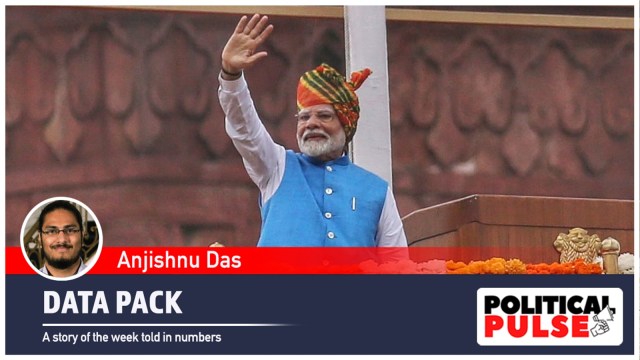PM Modi’s four key ‘castes’ – women, youth, farmers, poor – figure in I-Day speech. How do they fare?
“Only the uplift of these four castes will make India developed,” he said ahead of the LS polls. The process has been long – and slow
 With the PM addressing the country on the 78th Independence Day on Thursday, and with these four “castes” and the government's efforts to lift them featuring in his speech at the Red Fort, a look at what socioeconomic indicators say about their status
With the PM addressing the country on the 78th Independence Day on Thursday, and with these four “castes” and the government's efforts to lift them featuring in his speech at the Red Fort, a look at what socioeconomic indicators say about their statusLast December, as parties drew the battlelines for the recently concluded Lok Sabha polls, Prime Minister Narendra Modi said that he considers the women youth, farmers and the poor as the “biggest castes”, and that uplift of these four will drive development of the country.
“For me, there are four biggest castes in the country. For me, the biggest caste is the poor. For me, the biggest caste is the youth, the biggest caste is women. For me, the biggest caste is farmers,” Modi had said. “Only the uplift of these four castes will make India developed. And if we get it to these four, it means we get it to everyone,” he said.
With the PM addressing the country on the 78th Independence Day on Thursday, and with these four “castes” and the government’s efforts to lift them featuring in his speech at the Red Fort, a look at what socioeconomic indicators say about their status:
Women
Of India’s roughly 140 crore population, women account for an estimated 68 crore in 2024, as per projections based on the 2011 Census. But despite their numbers, women remain underrepresented in the Indian workforce. The latest Periodic Labour Force Survey (PLFS), published by the Ministry of Statistics and Programme Implementation (MoSPI), shows that just 20.3% of urban women were in the workforce between January and March 2024, compared to 58% of urban men. In 2022-23, 27.8% of women in urban and rural India were actively working or seeking work, compared to 56.2% of men. Not only are women absent from the workforce, they also face a higher unemployment rate than men – 5.4% against 2.9%, respectively, in 2022-23.
Women aren’t just underrepresented in the workforce; they also have lower literacy rates and on average complete fewer years of schooling than men. According to the National Family Health Survey (NFHS), 71.5% of women were literate in 2019-21 compared to 84.4% of men. While 41% of women had 10 or more years of schooling in 2019-21, the corresponding figure for men was 50.2%.
In terms of access to technology, just 33.3% of women were found to have ever used the Internet compared to 57.1% of men, according to the NFHS. Though mobile phones have proliferated across the population since the turn of the century, just 54% of women have mobile phones that they use themselves.
Youth
India is among the youngest countries in the world – almost a third of its population is aged 15 to 29 years old. According to projections based on the 2011 Census, 74.5 crore Indians were under the age of 30, including 37 crore between the ages of 15 and 29, in 2021. By 2026, the under-30 and the 15-29 population would have begun shrinking, and by 2031, the over-50 population is expected to catch up with the 15-29 population, at roughly 35 crore.
India was expected to cash in on this demographic dividend – of its working-age population exceeding its dependent population. However, in reality, things have not panned out exactly.
The PLFS for January-March 2024 shows that in urban India, just 40.7% of the population aged 15 to 29 was engaged in the workforce and their unemployment rate stood at 17% (compared to 6.7% for the overall population).
Data published by the MoSPI in its ‘Youth in India 2022’ report showed that just 58.29% of those in the 15-29 age group had completed secondary- and higher-level education, while 35.8% had completed schooling till primary or middle school, and 5.9% were illiterate.
The report also found that in 2019, before the Covid-19 pandemic, 63.4% of those aged 15-29 were engaged in only unpaid work while 31.9% were involved in all paid work. The gender divide here is stark – while 39.4% of men in this age group were engaged in unpaid work, the corresponding figure for women was 87.5%.
Farmers
Though agriculture as a sector is not the largest contributor to the Indian economy, it accounts for the largest share in the total workforce. In 2022-23, agriculture accounted for 18.3% of the Gross Value Added (GVA) in the economy, but employed 45.8% of the total workforce. These figures have stayed largely constant since 2019-20. An MoSPI report found that the Indian economy needs to generate an average 78.5 lakh non-agriculture jobs every year till 2030 to accommodate the growing workforce and the decline in farm-related jobs.
Data compiled by the Reserve Bank of India shows that the agriculture sector has been growing consistently over the past decade. In 2014-15, India produced 2,527 lakh tonnes of foodgrains spread across an area of 1,243 lakh hectares for a yield of 728 kilograms per hectare. By 2022-23, these figures had risen to 3,305 lakh tonnes, 1,322 lakh hectares and 944 kilograms per hectare.
Despite the expansion of the sector, which grew at 4.7% in 2022-23 and 1.4% in 2023-24, the daily wage rate for general agricultural work for rural men grew more slowly from Rs 224.6 in 2014-15 to Rs 345.7 in 2022-23. Data published by the National Statistical Office (NSO) for 2019 showed that most agricultural households have small landholdings – 27.8% between 0.01 and 0.4 hectares, 34.4% between 0.4 and 1 hectares, and 20.2% between 1 and 2 hectares – and it’s these households that have the lowest average monthly incomes and the highest indebtedness.
Agricultural households with 0.01 to 0.4 hectares of land earn an average Rs 7,522 a month and have an average outstanding debt of Rs 33,220. Those with landholdings between 0.4 and 1 hectares earn Rs 8,571 per month and owe Rs 51,933 on average, while those with 1 to 2 hectares make Rs 11,449 a month and have Rs 94,498 in debts on average. In contrast, those with more than 10 hectares of land, who account for just 0.6% of agricultural households, earn Rs 60,758 a month and have outstanding debts of Rs 7.9 lakh.
Though the Modi government has not favoured loan waivers at the central or state levels, in 2018 it launched the PM Kisan Samman Nidhi (KISAN) scheme to provide a guaranteed Rs 6,000 a year to farmers with landholdings up to 2 hectares. The latest instalment of the scheme in June released Rs 20,000 crores to 9.26 crore beneficiaries.
Poor
India has measured poverty only a handful of times in its history, most recently with the Multidimensional Poverty Index (MPI) developed by the NITI Aayog. The MPI measures “acute deprivations in health, education, and living standards that a person faces simultaneously” in addition to income and expenditure levels to determine the poverty rate.
The MPI put the share of the population living in “multidimensional poverty” at 53.7% in 2004-05. This figure fell to 24.9% by 2015-16 and further to 15% in 2019-21. This decline in poverty has coincided with a consistent rise in the annual per capita income, from Rs 77,659 in 2015-16 to Rs 1.07 lakh in 2023-24.
However, other proxy measures of poverty, including ownership of assets and certain goods, show that there is still a long way to go to eliminate poverty. The latest NFHS found that 60.3% of Indians live in pucca houses, 33.9% in semi-pucca houses, and 4.6% in kaccha houses. While the proliferation of mobile phones has eliminated the need for televisions, radios and computers to an extent, still just 48.8% of Indians have access to the internet. Household items like refrigerators, air conditioners and washing machines continue to be out of reach for most Indians, with just 37.9%, 23.7% and 18%, respectively, reporting that they own these items. With 45.1% of households qualifying for “below-poverty line” cards that make them eligible for certain schemes, it’s no surprise then that the government recently extended for five years the free ration scheme, which provides 5 kg free food grains to 80 crore beneficiaries.
More troubling is data on income and wealth inequality. A study by the World Inequality Lab showed that in 2022-23, the top 10% of the population held a 57.7% share in the total income with an average annual income of Rs 13.52 lakh. In contrast, the bottom 50% of the population held just a 15% share of the total income with average annual earnings of Rs 71,163. Wealth inequality is even more stark – while the bottom 50% held 6.4% of the country’s total wealth, the top 10% of Indians held 65% and the top 1% alone held 40.1%.







- 01
- 02
- 03
- 04
- 05
























